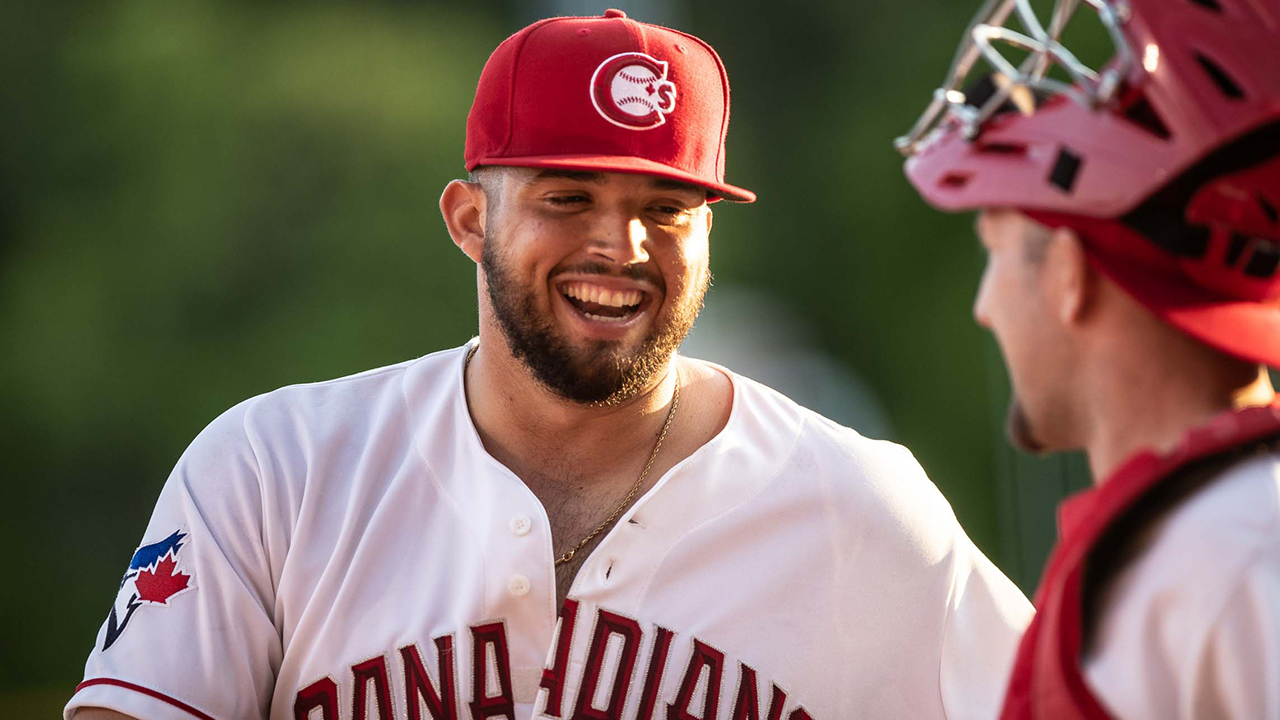At only eight months old, Alek Manoah was putting back plates of rice and beans. When he was 10, he took a pitch off his face during a youth league championship game, broke his jaw, and still finished his outing. By 17 he was 6-foot-5, 250 pounds, throwing a fastball in the mid-90s, batting .400 and winning a Florida state high school championship.
At 18, he turned down a six-figure offer from the Texas Rangers to turn pro, betting on himself and going off to college to improve his draft stock. As a 21-year-old at West Virginia, he broke a single-season strikeout record that had stood since 1964, was drafted in the first round, and signed for over $4.5 million. Months later, in his home debut for the Vancouver Canadians, he drilled a batter with the first pitch he threw — dude was crowding the plate, Manoah contends — before going on to strike out seven over three hitless innings, as 100-mph flashed up on the scoreboard.
Yeah, he’s coming right at you. Size 17 cleats driving all 6-foot-7, 260-plus pounds of him downhill, followed by a tattooed right arm and a heavy fastball that runs, sinks and misses bats all over the zone. Manoah’s power comes so easily he says he doesn’t ever think about it on the mound.
Scorching! WVU’s Alek Manoah – Over the past three weeks: 3-0, 2CG, 10hits, 0 walks, 41k and is on a 31 scoreless inning streak! #HailWV pic.twitter.com/aMeLGUn7dC
— Mike Montoro (@reddubvu12) April 20, 2019
“I don’t have to. The velocity’s always just been there. I don’t have to worry about trying to throw hard — it just happens,” he says. “It’s a blessing. With my size and arm strength, I can just focus on keeping my head and body still and trying to pinpoint my command. If I can control my mechanics consistently and keep my head in line, my arm’s going to listen.”
And that’s his challenge — the one that will dictate the kind of professional career Manoah ends up having after Toronto selected him No. 11 in the 2019 draft. Can this massive, lightning-armed 22-year-old command his epic stuff, polish his approach and develop into a frontline starter? Can he not only blow high-90s cheese past hitters, but locate it on the edges of the strike zone? Can he establish his changeup, taking it from an average pitch he rarely threw in college to the legitimate weapon he’ll need it to be in the majors?
Manoah’s far from the only young starter in the Blue Jays’ system developing a changeup; it seems like they all are. But for him, the pitch could be the difference between whether he sticks as a starter or — as every scouting report you read on him will warn of — ends up in the bullpen.
Not that the latter would be such a bad outcome. Every good team needs big arms to get high leverage outs late in games. And as Craig Kimbrel, Zack Britton and others have proven, you can have a long, lucrative career with only two pitches if you’re consistent and healthy.
But the best outcome, for both Manoah and the Blue Jays, sees him leveraging his exceptionally large frame to log a full starter’s workload season after season. Like Aaron Harang or C.C. Sabathia. Or maybe even better.
Called strike 3!! Alek Manoah strikes out 3 after a leadoff double! He has a career-best strikeouts tonight.
M-8, WVU 2, #11 TTU 0
https://t.co/d8MC7S7h7u #HailWV pic.twitter.com/FRWin3nPbj
— WVU Baseball (@WVUBaseball) April 13, 2019
“We fully believe he’ll be able to pitch in a big league rotation someday,” says Gil Kim, the Blue Jays director of player development. “Right now he’s just developing the habits that will allow him to do that. He’s developing his routine. Mentally and physically, it’s extremely challenging to execute to the standards of a big league starter, throwing 200-plus innings. Alek’s already learned a lot about what goes into that — and I’m sure he’ll continue to learn a lot more.”
It’s been a quick education. Manoah didn’t truly focus on pitching until his junior year at Miami South Dade High School when his older brother, Erik, graduated and left a hole on the team’s staff. (Erik played parts of six minor-league seasons in the New York Mets and Los Angeles Angels organizations and is now a free agent.) Alek didn’t know the first thing about proper mechanics at the time. He would just take the ball and whip it at the plate as hard as he could, usually somewhere around 90-mph.
[snippet id=4722869]
It wasn’t until that summer, while playing travel ball for the Atlanta Blue Jays, that Manoah learned how to generate power with his lower half and developed a more efficient, repeatable delivery. Suddenly, his velocity shot up to 95.
More tweaks and adjustments have occurred since, and now Manoah’s living in the high 90s. He backs it up with a mid-80s slider he learned to throw from watching Pitching Ninja videos and scouring the internet for articles in which big-leaguers explained how they threw theirs. Manoah took Dellin Betances’s cutter grip, added in the way Chris Sale uses his thumb to manipulate his slider, and tweaked it to make the action more comfortable from his arm angle.
Of course, it wasn’t easy. Early in the process the slider would came out of Manoah’s hand at 90-mph, which made it tricky to locate. But as he learned to harness the pitch and slow it down, its shape improved and it became a multipurpose tool. Often, Manoah will use it to get right-handed hitters to chase out of the zone. Sometimes, he’ll back-foot it to lefties. And occasionally he’ll drop it in for a knee-buckling strike like this one:
“I try to throw it out front,” he says. “I try to think fastball away. And then when I get out front, I just break it off. It kind of just stays on the same plane as the fastball and then breaks off. To lefties, I’ll manipulate it differently. If I’m ahead in the count, I’ll manipulate it differently. I’m not just trying to flip it in there for a strike.”
The changeup is another story. Manoah never really needed it against swing-happy college hitters who couldn’t catch up to his fastball and waved at his sliders. And whenever he did throw his off-speed stuff it’d come right back at him, as hitters who were late on Manoah’s fastball were right on time for his changeup.
Manoah’s confidence in the pitch waned, so he stopped throwing it. But now, facing professionals who can time up his heater, he needs it more than ever. And its development might just be the fulcrum of whether his career progresses in a rotation or a bullpen.
Durability will go a long way, too. Manoah was limited to only 17 innings with low-A Vancouver in his pro debut last summer — he put up a 2.65 ERA with 27 strikeouts to five walks — after logging 108.1 innings with West Virginia earlier in the season. His weight has fluctuated throughout his life and a big focus going forward will be conditioning and nutrition, as Manoah attempts to tap into the athleticism that could allow him to log heavy innings with such a large frame. And continue making plays like this:
Prior to the coronavirus shutdown this spring, Manoah was working closely with Blue Jays pitching coordinator Corey Popham on using Rapsodo data and Edgertronic video to improve his secondary weapons. He was training regularly with fellow top pitching prospect Simeon Woods-Richardson, who was on a similar throwing program featuring plenty of long toss.
Manoah was honing the arm care routine that will help him make the adjustment from a seven-day college rotation to a five-day professional one. He was likely heading out on the Nate Pearson progression path, skipping mid-A Lansing and starting his first full season at high-A Dunedin. He could’ve been up to double-A in the latter half of the year if results warranted, setting the stage for an MLB debut as soon as 2021.
But then baseball stopped. And now nothing is certain. The next step in his progression will likely be as part of Toronto’s entry into a summer instructional league or souped-up Arizona Fall League, assuming it comes to fruition. That exposure against top competition will be great — certainly better than nothing. But the real experience Manoah needs is a full baseball season spent turning lineups over three times, every five days, for months.
Manoah’s 2020 should have looked something like Pearson’s 2019 — around 25 starts, up over 100 innings, forcing his way north through the minors. But then again, no one’s 2020 played out the way they thought it would. Still only 22, Manoah will have to patiently wait for his next opportunity to pitch out of a rotation. And he knows exactly what he’ll do when that day arrives.
“I just want to continue to prove that I’m a starter — going out there every five or six days and throwing until they tell me to stop,” he says. “Obviously, I’ve shown my potential as a starter. Now, I’m just going to continue to prove that I’m here to stay. That I can command all my pitches, that I can strike guys out, not walk guys — and just get outs. You step in the box and I’m going to get you out. That’s all I need to do.”
[relatedlinks]









